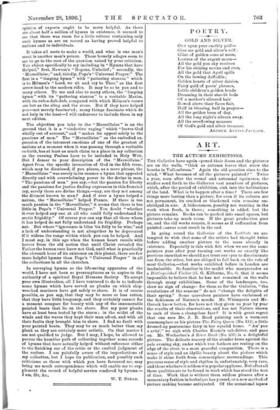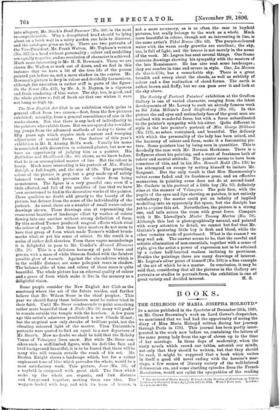ART.
THE AUTUMN EXHIBITIONS.
THE Galleries have again opened their doors and the pictures are on the walls, "thick as autumn leaves that strew the brooks in Vallombrosa." Again the old question rises to the mind, "What becomes of all the pictures painted ? " Twice a year, soon after the vernal and autumnal equinoxes, the studios send forth to the Galleries vast numbers of pictures, which, after the period of exhibition, sink into the habitations of the land. What is to happen after a time ? There are few things more lasting than a picture, for even if its colours are not permanent, its cracked or blackened ruin remains un- abridged in size. A hideousness, possibly not wanting in the work when fresh, is there ; something is added, but the picture remains. Books can be packed into small spaces, but pictures take up much room. If the great production goes on, and the old works remain, it seems as if suffocation from painted canvas must result in the end.
In going round the Galleries of the Institute we are tempted to wish that some of the artists had thought twice before adding another picture to the mass already in existence. Especially is this wish felt when we see the same painters year after year turning out works so exactly like previous ones that we should not trust our eyes to discriminate one from the other, but are obliged to fall back on the rule of most Galleries,—that works exhibited before in London are inadmissible. So familiar is the model who masquerades as a Distinguished Visitor (G. G. Xilburne, No. 6) that it seems impossible to believe that he has not remained on the walls through many exhibitions. Some of the landscapes, too, show no sign of change: for them as for the Galistitn, "the revolutions of the seasons" do not "change the delights of their spring." Some querulous painters have exclaimed at the fickleness of Nature's moods. Mr. Whimperis and Mr. Orrock know better, for have not they given us year by year the results of their observations, and has not Nature shown to each of them a changeless face? It is with great regret that one sees Mr. J. R. Reed painting such a worn-out commonplace as his picture The Fairy Queen (No. 112), a little dressed-up pantomime fairy in her squalid home. "An' you a alike," we sigh with Charles ICeene's cab-driver, and pass on. Mr. Wetherbee's A River Bank (No. 231) is a delightful picture. The delicate tracery of the slender trees against the pale evening sky, under which two bathers are resting on the edge of the river, is a most graceful composition. There is a sense of style and an idyllic beauty about the picture which make it shine forth from commonplace surroundings. This precious sense of style and rhythm is, unfortunately, very rare, and those who have it seldom win popular applause. But after all these qualities are to be found in work which has stood the test of time. Work that is without them seldom pleases after a, momentary fashion in technique has passed, or a new method of picture making become antiquated. Of the occasional lapses into allegory, Mr. Stock's Dead Summer (No. 308) is the most incomprehensible. Why a decapitated head should be lying about on a brick wall in a misty garden one fails to discover, and the catalogue gives no help. There are two portraits. of the Vice-President, Mr. Frank Walton. Mr. Topham's version (No. 317) is a head without personality ; colour and modelling are equally negative, and no revelation of character is achieved. Much more interesting is Mr. H. E. Bowman's. There we are shown Mr. Walton at work out of doors, and we feel in this instance that we have a bit of the true life of the person painted put before us, not a mere shadow on the canvas. Mr. Bowman's picture is deep in colour and decidedly harmonious, although the execution is rather stiff in parts of the figure. On the Scaur (No. 453), by Mr. A. S. Haynes, is a vigorous and fresh rendering of blue water. The sky, too, is good, and the whole picture so full of fresh air that one wishes it were not hung so high up.
The New English Art Club is an exhibition which gains in general effect from two canses,—first, from the few pictures exhibited ; secondly, from a general resemblance of aim in the works shown. Not that there is any lack of individuality in the painters who exhibit there. But we are spared the bewilder- ing jumps from the advanced methods of to-day to those of fifty years ago which require such constant and worrying adjustment of mental focus. One feature of this year's exhibition is Mr. It. Anning Bell's work. Usually his name is associated with decoration in coloured plaster, but now we have an opportunity of judging him as a painter. His Battledore and Shuttlecock (No. 60) shows, as we knew before, that he is an accomplished master of line But the colour is heavy. Much more interesting is his portrait of .211re. Walter Raleigh, a full-length, and the size of life. The prevailing colour of the picture is grey, but a grey made up of subtly balanced tones, which prevents the colour from being monotonous. The figure is a very graceful one, even if a little affected, and full of the qualities of line that we have 'Jeen accustomed to find in the decorative works of the painter. These qualities no doubt add greatly to the beauty of the picture, but detract from the sense of the individuality of the portrait. As usual, there are a number of small water-colour drawings shown. These drawings aim at representing the evanescent beauties of landscape effect by washes of colour flowing into one another without strong definition of form. By this method Turner produced magical effects which rival the colour of opals. But these later masters do not seem to have that grasp of form which made Turner's wildest brush. marks vital, or yet his sense of colour. So the result is a series of rather dull sketches. From these vague meanderings it is delightful to pass to Mr. Conder's Almond Blossoms (No. 28). This is a delicious harmony of pale blues and greens, with a mass of white blossom flushed with the faintest possible glow of warmth. Against the almond-tree which is in the middle distance are some pale-pink roses in shadow. The balance alike of tone and colour of these roses is quite beantifuL The whole picture has an ethereal quality of colour and a grace of form which make it live in the memory as a delightful vision.
Some people consider the New English Art Club as the sanctuary where the art of the future resides, and further believe that Mr. Wilson Steer is the chief prophet. This year we should fancy these believers must be rather tried in their faith. Until Mr. Steer condescends to paint something rather more beautiful than A Nude (No. 68) many will prefer to remain outside the temple with the heathen. A few years ago this artist's admirers proclaimed a new Claude Monet ; but the sceptical saw only streaks of brilliant paint, not the vibrating coloured light of the master. Then Tintoretto's portraits were quoted to find an equal to a new departure of Mr. Steer's. Now no doubt we shall be told that the Rokeby Venus of Velasquez lives anew. But while Mr. Steer con- siders such a stiff-limbed figure, with its doll-like face and livid background beautiful, it is to be feared that there will be many who will remain outside the reach of his art. Mr. Buxton Knight shows a landscape which, but for a rather unpleasant tone of blue which pervades the whole, would be a most satisfactory work. This picture, June (No. 56), of a hayfield is composed with great skill. The lines which make up the whole are organic, and link distance and foreground together, making them one idea. The -waggon loaded with bay, and with its team of horses, is not a mere accessory, as is so often the. ease in hayfield pictures, but really belongs to the work as a whole. Much more beautiful in colour, though not so interesting in line, is the same artist's Tidal Breeze (No. 62). The purple-coloured water with the warm reedy growths are excellent; the sky, too, is fall of light, and the breeze is not merely in the name of the work. Mr. Legros has Bent several things. One frame contains drawings showing his sympathy with the masters of the late Renaissance. He has also sent some landscapes ; they are sombre in tone and severe in style. One, La Maison du Garde-Cote, has a remarkable sky. There is a great breadth and sweep about the clouds, as well as subtlety of colour and a fine realisation of cloud-forms. The earth is. rather brown and fluffy, but we can pasa over it and look at the sky above.
The Society of Portrait Painters' exhibition at the Grafton Gallery is one of varied character, ranging from the latest developments of Mr. Lavery to such an already famous work as Sir John Millais's Lord Shaftesbury (No. 65). In this picture the sad eyes and melancholy face of the great man are realised with wonderful force, but with a force subordinated' to the painter's sympathy with his sitter. Quite different in style is the late painter's portrait of Mrs. George Stibbard (No. 113), so sober, restrained, and beautifuL The delicacy with which the personality of the lady has been seized, and the harmony of colour and form, make it a fascinating pic- ture. Some painters lose by being Been in quantities. This is decidedly the case with Mr. Herman Herkomer. There is s fluffyness about his painting, and a want of freshness both of colour and mental attitude. The painter seems to have been conscious of this, and in his Mrs. Rennell Rodd (No. 138) he has attempted an escape by setting himself to imitate Mr. Sargeant. But the only result is that Mrs. Hammersley's velvet seems faded and its freshness gone, and an effective mannerism in painting arms does not do at second-hand. Mr. Guthrie in his portrait of a little boy (No. 83) definitely aims at the manner of Velasquez. The pale face, with the pupils of the eyes and lips showing as patches, is not entirely satisfactory ; the master could put an infinity of implied* modelling into an apparently flat space, but the disciple has yet to acquire this art. Nevertheless, the picture is a strong one, and tells across the room with great force. Compare with it Mr. Llewellyn's Master Tommy Merton (No. 70). Although this last is photographically natural, and painted with every attention to detail, we cannot but feel that Mr. Guthrie's posturing little boy is flesh and blood, while the- other remains made of pasteboard. What is the reason ? we. may well ask. The answer seems to be, that the careful and artistic elimination of non-essentials, together with a sense of style, give the artist a power of expression not to be attained- by a rather half-hearted realism inclining to prettiness. Besides the paintings there are many drawings of interest. Mr. Legros's silver point of himself (No. 188) is a fine example of the art of which he is a master. In conclusion, it may be said that, considering that all the pictures in the Gallery are- portraits or studies in portrait-form, the exhibition is one of
great variety and decided interest. H. S..











































 Previous page
Previous page